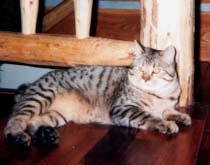


Lynn
& Bart's Baby

Linna
& Rusty's Boy King

Matt's
Baby

Allen's
Boys Jeepin'

Lisa
Paonessa's Rambo

Sherri
Bentham's Baby
 More
PetZ...
More
PetZ...

Click to Blue Letters Below to
check out their site and get facts sent to you!!!
Feline
Facts!
KITTY-CAT OLYMPICS
More ideas to make your cat's life (and consequently, your life) more
fun:
* Get a feline companion for your cat -- one with a compatible personality
and a similar activity level.
* Schedule at least one 15-minute interactive play session with your
cat
and a fishing pole-type toy each day.
* Install a window perch with a view of the birdfeeder.
* Provide a goldfish bowl or an aquarium to watch when the birds are
not
at the feeder.
* Drop a couple of Ping-Pong balls in the bathtub (feline racquetball).
* Slide milk bottle rings or ice cubes across the kitchen floor (feline
ice hockey).
* Stuff cotton socks of varying sizes with cotton balls and catnip.
* Set out something new to explore from time to time like a cardboard
box
or a paper grocery bag (without handles).
* Flash a beam of light on the walls and floor of a dimly lit room
-- use
a flashlight or a laser pointer (DO NOT point laser beam into the eyes).
* Provide your feline with some cat furniture -- something great to
climb,
perch on, and to scratch.
* Get a video made for cats or a wildlife show featuring birds.
----------------------------------------------
And now for today's tip...
ADDING ANOTHER CAT?
Planning to add a cat to your household? The introduction process
is all-
important. First impressions can be lasting impressions for felines.
In
the wild, cats take great care to prevent chance encounters with other
cats
through scent-marking behaviors. By "reading" the marked areas,
cats can
tell who was there last and at what time he visited the spot.
The territory
can then be used by different cats at different times of the day--the
feline
version of time-sharing. In order to get your cat used to the idea
of sharing
the home turf with another feline, a gradual introduction is essential.
More
about introductions tomorrow...
----------------------------------------------
ADDING ANOTHER CAT II
Time and patience are the keys to successfully introducing a new cat
into
the household. The new cat should have a room of his own for
a few days.
Exchange the new cat's bedding with that of the resident cat so that
they
can become acquainted with each other through the all-important sense
of
smell before they have the opportunity to see each other. Next
rotate
rooms. Let the new cat explore the rest of the house while the
resident
cat spends some time in the new cat's room. When they are relaxed
about
this step, crack the door of the new cat's room and let them see each
other,
but not be able to push the door open. Give the cats treats on
both sides
of the door. Two small toys joined with a several inches of string
and
slipped under the door will encourage parallel play. When the
cats are
calm in each other's presence, it is time to let the new cat out for
a few
minutes. The length of the visits can be increased gradually
each day.
This process may take a few days or a few months depending on the
personalities of the cats.
---------------------------------------------------------------
CHOOSING THE RIGHT CAT FOR YOUR FAMILY--PART 4
If you already have a resident cat it is important to take this cat's
personality and activity level into consideration before selecting
a feline
companion. If you are too casual about this important decision,
your
house may become a war zone. Keep the following guidelines in
mind when
selecting your next family member. Remember that they are only
guidelines
and that there are occasional exceptions to the rule.
* If you have an adult female who has been an "only" cat for
some time,
it is best to get a younger female. Males, even friendly ones,
can over-
power and frighten females. Male kittens, while more easily dominated
by
the female, still grow up to be rambunctious teenagers that engage
in a
style of play that involves pounce and wrestle (not a female's idea
of fun).
* If a young active male is your family pet, he would really
enjoy having
a male buddy who shares his enthusiasm for vigorous play.
* A laid-back, older (neutered) male cat may enjoy "mothering"
a kitten--
male or female. They usually make better mother substitutes than
spayed
females. Females, in general, are less accepting of newcomers.
* Males tend to bond with each other unless both have dominant
personalities.
(A dominant cat engages in a lot of rubbing--scent marking--behavior,
likes
to rest in high places (for surveillance purposes) and in doorways
(to control
the entrance to certain rooms), and shows little or no fear.
Never try to
combine two dominant personalities--they will be in constant competition.
Whatever the combination, a slow, systematic introduction process will
help
to ensure that the resident cat and the newcomer will eventually share
the
house amicably.
===============================================================
THE SENSE OF SMELL
The cat's sense of smell, not vision, is its primary resource for
identifying the individuals and objects in its environment. The
cat's
visual acuity is 10 times less than that of humans. However,
they
have 200
million odor-sensitive cells in their noses compared to only 5 million
for
humans.
Cats live in a sensory world completely apart from ours. The sense
of smell plays a very insignificant role in human relationships and
in our
response to our environment, while for cats, it is all-important and
may
result in some puzzling and disturbing behaviors. Consider the
following:
1. The owner puts a scented litter in the litterbox--the cat
refuses to
use it. (Perfume is actually a repellent for cats.)
2. The owner comes home after visiting a friend and petting her
friendly,
lap-sitting cat--she is greeted with hisses and growls from her own
cat.
3. A new piece of furniture is moved into the house. The
unfamiliar scent
is upsetting to the cat and impels it to mark it with its own signature
scent.
----------------------------------------------
 Home.............
Home.............